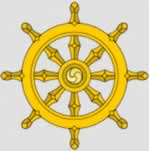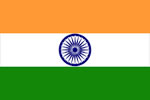MODERN BUDDHISM THE WHEEL THE DHARMACHAKRA
Modern Buddhism has taken yet another step away from the original meaning of Dukkha and the wheel. With the present day symbol of the Dharmachakra, the original teaching is completely obscured.
 The 17th century invention of the ship's wheel has a totally different use, and functions in a totally different way to the spoked wheel of Buddha's times.
The 17th century invention of the ship's wheel has a totally different use, and functions in a totally different way to the spoked wheel of Buddha's times.
It is probably its flamboyant appearance that has elevated it to a modern sacred Buddhist symbol.
The ship's wheel is found on many Buddhist websites, and wikipedia pages. Until around 2019, it was even used as the main symbol on the English Wikipedia page on Dukkha. Presently a more moderate version is in use, but the flamboyant ship's wheel can still be found in the 'infotip'.
The ship's wheel demonstrates an ability to steer one's path through life. I doubt if 17th century ships wheels even had the capacity to make one full turn, however the symbol probably came into use quite recently, subsequent to modern yachts with power assisted wheels. 
Sometimes, a more moderate version of the Dharmachakra is used. This appears to have no practical usage.
Neither of these Dharmachakras have the capacity to symbolise the turning and returning of the wheel, or rolling round in karmic repetitions.


 We can be thankful to Gandhi for the old fashioned wheel in the Indian flag. This developed from his use of the spinning wheel.
We can be thankful to Gandhi for the old fashioned wheel in the Indian flag. This developed from his use of the spinning wheel.
Back to Dukkha in Depth
Back to Chapter Four : Buddhism and Wheels
Back to THE PANORAMA SENSES Priority Pages